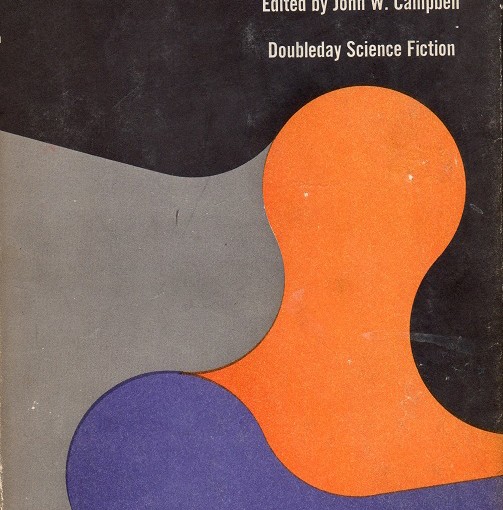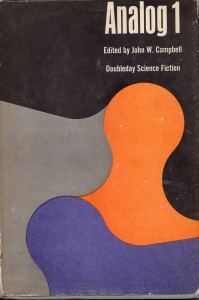Book Review: Analog 1 edited by John W. Campbell
Astounding Science Fiction was one of the most influential science fiction magazines from the 1930s to the 1950s. But long-time editor John W. Campbell had felt for years that the title did not reflect the more mature, “hard” science fiction he preferred to run. So in 1960, he finally got permission to transition the magazine over a period of months to Analog Science Fact and Fiction.
This volume is a collection of stories from that first year of Analog and as such is a time capsule of the science fiction genre at that moment. The opening editorial is perhaps a little hubristic, claiming that “mainstream literature” is just a subset of science fiction. Mr. Campbell touts the fun of science fiction being the way it allows the mind to stretch and struggle with new concepts. Then we begin the eight feature stories.
“Monument” by Lloyd Biggle, Jr. concerns a planet that is a tropical paradise, inhabited by primitive, peaceful humanoids. A lone spaceman stumbles on the place, and lives out his life in peace…until near his death, he realizes that inevitably more humans will come, and given the history of tropical paradises on Earth, this will result in disaster for the natives. He comes up with a plan. Some time later, galactic civilization indeed comes calling. All unfolds as O’Brien had foreseen–greedy developers, broken treaties, military men with their hands tied by regulations. The people of Langri have the Plan, but will it come off in time?
This is the longest piece in the volume, being a full-fledged novella. The critique of colonialism is pointed enough to sting a bit. The greedy capitalist who doesn’t really hate the natives, but doesn’t understand that their interests should come ahead of his own, and so does them dirt, is the major villain of the piece. He’ll be quite willing to employ the locals as maids and laborers in the hotels he’s building, once they’re properly put in their place. He’s blind to the way he’s being outmaneuvered, and even the sympathetic military men don’t quite grok what the natives are really up to.
“The Plague” by Teddy Keller is set in the then present day. The obscure Pentagon office of Protection from Germ Warfare had the previous officer retire a few weeks ago, and his replacement is tied up in red tape somewhere. So when a plague breaks out, Sergeant Major Andrew McCloud and Corporal Bettijean Baker are the spearhead of the effort to stop it, despite the military brass trying to interfere. A general is running interference, but if they don’t figure out why this illness has such a weird pattern of attack quickly, some new officer will be found to start all over.
The vector of spread is a clever one, and I have seen it in at least one other short story. Younger readers might not catch on until it is spelled out for them, as customs and technology have changed since 1960. There’s a whiff of the period’s sexism in regards to how grown women in the military are referred to as “girls.”
“Remember the Alamo!” by T.R. Fehrenbach is a time travel tale. A scholar has gone back to observe the Battle of the Alamo, infiltrating the small garrison to get the full details. Mr. Ord doesn’t quite grasp that the differences piling up between the history he knows and the events he is experiencing aren’t just trivialities he can dismiss. The end result is telegraphed because we see the thoughts of those around Ord, and what they’re not telling him, since he should already know it.
“The Hunch” by Christopher Anvil features scout ship pilot James Connely, who is informed that two scout ships have vanished in a certain sector, despite having the latest equipment. So his ship is being refitted with even newer equipment. Equipment he has no chance to test before being launched into that same sector. As it happens, his hunch that one of these devices is actually responsible for the disappearance of the other ships is correct. But which one of these newfangled gadgets is it? This story is heavy on the sarcastic humor.
“Barnacle Bull” by Winston P. Sanders is a rarity, in that the protagonists are a Norwegian space crew in the “near future” flying the Hellik Olav in an attempt to find a safe way through the asteroid belt. They discover why none of the other ships ever reported back. Space barnacles. This is one of those stories where the problem is in fact its own solution, looked at a different way.
“Join Our Gang?” by Sterling E Lanier concerns a galactic civilization attempting to convince a newly discovered planet to join them. Sadly, the aliens are refusing, so it is time to apply pressure. Turns out that invasive species are an Earth specialty. Not exactly a happy ending to this one, more of a “that’s just the way it goes.”
“Sleight of Wit” by Gordon R. Dickson stars another scout, Hank Shallo lands on the same planet, in almost the spot as, the first alien scout humanity has ever met. The alien’s ship is heavily armed, while Hank’s has no conventional weaponry. But as he warns the alien, Hank is in possession of the universe’s most deadly weapon, one that cannot be detected or stopped. Or is he bluffing? Does the alien dare find out for sure?
“Prologue to an Analogue” by Leigh Richmond is the sole non-“hard” SF story in the volume. We’re back in the present day, as an advertising campaign featuring “witches” proves successful in unexpected ways. For younger readers, I should mention that many television programs used to be wholly owned by a particular advertiser, so a cleaning product company hosting its own nightly newscast wouldn’t have been considered unusual. The story is also tied heavily to the politics of 1960, with tensions between the USA, the Soviet Union and Red China important to the way the plot unfolds. The actual mechanism of the events is never explained. Psionics? The will of God? Actual witches? Who knows? A rather frustrating tale, as intended.
These aren’t all-time classic stories, a couple are very dated, but are pretty good representatives of the magazine’s content. It’s been reprinted a few times, and some of the other covers are better–check your local library or used book store.


